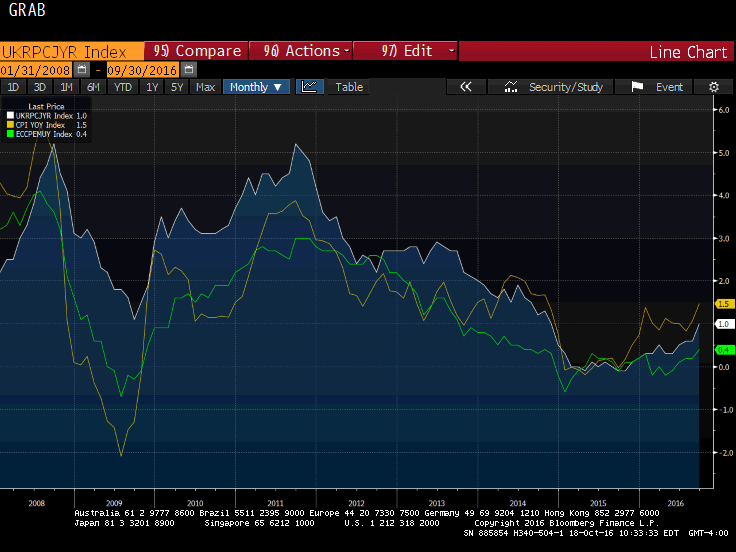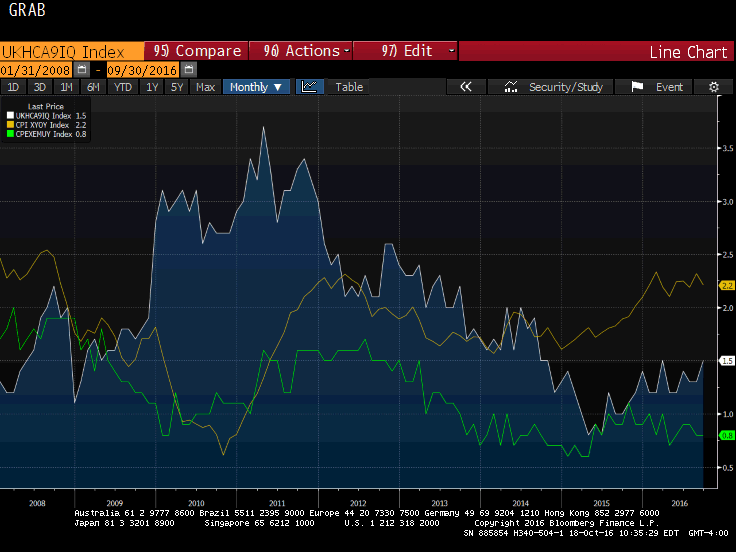Back in the early post-crisis days, many pundits consumed lots of ink and column inches warning the strong inflationary pressures would be fueled by the orthodox and unorthodox monetary policy. Not only did this not materialize, but policymakers cannot seem to generate much inflation in broad measures of prices, such as captured in the CPI.
The weak price pressures despite the huge expansion of central bank balance sheets, negative interest rates, and otherwise accommodative monetary policies have lulled many observers into a false sense of security. This is similar to how the Great Moderation led many to argue that the business cycle was dead.
While the crisis was profound, and numerous industries globally have excess capacity, distinct from the challenges emanating from China, economic laws have not been repealed. Just as pundits talk about the death of inflation, it will rear its head.
This Great Graphic from Bloomberg compares the headline CPI of the UK (white line), US (yellow line) and the EMU (green line). As recently as last September, the CPI measures were nearly identical. The UK CPI was at -0.1% as was EMU. Headline US CPI was at zero.

As of last month, the UK's CPI was at 1.0%, and the US CPI was 1.5%. EMU is the outlier, but its CPI also appears to have bottomed and stood at 0.4% last month.
This is more than simply the nearly 40% rise in oil prices this year. Core measures of inflation are also rising, though here too the EMU is lagging. These are shown in the lower chart.
The UK's core measure (white line) has risen from 0.8% in June 2015 to reach 1.5% in both March (before the Brexit-induced slide in sterling) and September 2016. It is above the 12- and 24-month averages for the first time since 2011.

The US core CPI (yellow line) was flat in last month at 2.2%. At the end of 2014, it stood at 1.6% and did not rise above 2.0% until the middle of Q4 15. The September reading matches the year's average. US core CPI has been above the 12- and 24-month averages since the middle of last year.
The eurozone core CPI (green line) is struggling to maintain upside momentum, but it is not falling as it was from mid-2012 until early-2015. Core CPI bottomed in the first part of last year near 0.6%. It spiked to 1.1% last October but has since drifted off to 0.8%. It is the subdued price pressures that might make the most compelling argument to extend the ECB's asset purchases. A decision is not expected at this week's meeting, but in December.
That said, although Draghi (and several others at the ECB) argues that the overall thrust of monetary policy, including the asset purchases, have been and continue to be successful, many economists and investors are skeptical that bond purchases are really lifting consumer prices. However, once ventured down this road, backtracking can be counterproductive, even if the course was not initially effective. Any nod toward ending its asset purchase, even if tapered rather than an abrupt end, would see rates rise dramatically, and if sustained, could be a break on the economy and the creations of aggregate demand.
Nevertheless, barring a new shock, it does seem as if the UK, US, and EMU have seen the low point of inflation. This does not mean investors should expect a dramatic rise in prices, but rather the gravest deflationary dangers have likely passed. Nor does this mean that stagflation is the next scenario. Economic growth may be less than desired, but US, UK, EMU, and even Japanese growth is near or above trend growth.
